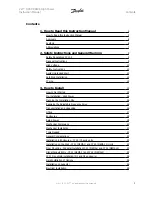
3-29
•
This value will be automatically set during autotuning. See “Motor parameter
autotuning selection” on page
3-73
.
•
Increase the setting when the generating torque is not large enough at low speed.
•
Decrease the setting when the generating torque is extremely high and cause
overcurrent trip at low speed.
(54)
Motor Rotor Equivalent Resistance R2
(Cn-58)
•
Set the motor’s rotor Y-equivalent model resistance in unit.
•
The default setting depends upon the type of inverter. Normally this value isn’t
shown on the motor’s nameplate, so it might be necessary to contact motor
manufactor.
•
This value will be automatically set during autotuning. See “Motor parameter
autotuning selection” on page
3-73
.
(55)
Motor Leakage Inductance Ls
(Cn-59)
•
Set the motor’s rotor Y-equivalent model leakage inductance in mH unit.
•
The default setting depends upon the type of inverter.
•
This value will be automatically set during autotuning. See “Motor parameter
autotuning selection” on page
3-73
.
(56)
Motor Mutual Inductance Lm
(Cn-60)
•
Set the motor Y-equivalent model mutual inductance in mH unit.
•
The default setting depends upon the type of inverter.
•
This value will be automatically set during autotuning. See “Motor parameter
autotuning selection” on page
3-73
.
Note: The Induction Motor Y-equivalent model
I
d
I
q
L
m
Ls
R1
R2
s
s : slip
(57)
Slip Compensation Gain
(Cn-61)
•
The parameter Cn-61 improves speed accuracy while operating with a load.
•
Usually, the setting Cn-61 need not be changed. Adjust the setting if the speed
accuracy is needed to improve.
•
When actual speed is low, increase the set value.
•
When actual speed is high, decrease the set value.
















































